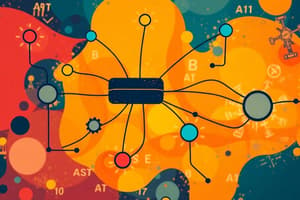Podcast
Questions and Answers
Which characteristic of a reliable network ensures that performance does not degrade as the network expands?
Which characteristic of a reliable network ensures that performance does not degrade as the network expands?
- Quality of Service (QoS)
- Fault Tolerance
- Security
- Scalability (correct)
What is the main function of intermediary devices in a network?
What is the main function of intermediary devices in a network?
- Connect devices to Wi-Fi networks
- Store and retrieve user data
- Provide end users with direct internet access
- Manage the data flow between different networks (correct)
Which type of network connects multiple LANs over large geographic regions?
Which type of network connects multiple LANs over large geographic regions?
- Wide Area Network (WAN) (correct)
- Wireless Local Area Network (WLAN)
- Personal Area Network (PAN)
- Local Area Network (LAN)
Which of the following is a primary security measure for large networks?
Which of the following is a primary security measure for large networks?
Which media type is NOT typically associated with network connections?
Which media type is NOT typically associated with network connections?
What does BYOD stand for in the context of networking trends?
What does BYOD stand for in the context of networking trends?
In network security, what type of threats can come from within an organization?
In network security, what type of threats can come from within an organization?
What is the term used for the layout of a network, whether physical or logical?
What is the term used for the layout of a network, whether physical or logical?
Which technology integration is often included in smart homes?
Which technology integration is often included in smart homes?
What method do networks use to enhance fault tolerance by splitting data into smaller pieces?
What method do networks use to enhance fault tolerance by splitting data into smaller pieces?
LANs typically cover a wide geographic area such as cities or countries.
LANs typically cover a wide geographic area such as cities or countries.
The Internet is a global network that solely consists of WANs.
The Internet is a global network that solely consists of WANs.
Quality of Service (QoS) ensures that all types of data are treated equally in a network.
Quality of Service (QoS) ensures that all types of data are treated equally in a network.
Packet switching improves security in a network by creating larger data segments.
Packet switching improves security in a network by creating larger data segments.
BYOD refers to the practice of using personal devices for professional purposes in a networked environment.
BYOD refers to the practice of using personal devices for professional purposes in a networked environment.
Intermediary devices like routers are essential for managing data flow in networks.
Intermediary devices like routers are essential for managing data flow in networks.
External threats to network security include accidental data breaches by employees.
External threats to network security include accidental data breaches by employees.
Fault tolerance in a network refers to the ability to sustain performance despite component failures.
Fault tolerance in a network refers to the ability to sustain performance despite component failures.
Fiber optic cables are an example of wireless media used in networking.
Fiber optic cables are an example of wireless media used in networking.
Scalability in a network implies the ability to grow without loss in performance.
Scalability in a network implies the ability to grow without loss in performance.
Flashcards
LAN
LAN
A local area network covering a small area like a house, office, or campus, with high speed and single administration.
WAN
WAN
A wide area network connecting LANs over large areas (cities, countries), managed by multiple providers with slower speeds.
Internet
Internet
A global network connecting LANs and WANs using various media like copper, fiber, and wireless.
Network Components (End Devices)
Network Components (End Devices)
Signup and view all the flashcards
Network Components (Intermediary Devices)
Network Components (Intermediary Devices)
Signup and view all the flashcards
Fault Tolerance
Fault Tolerance
Signup and view all the flashcards
Scalability
Scalability
Signup and view all the flashcards
QoS (Quality of Service)
QoS (Quality of Service)
Signup and view all the flashcards
Network Security Threats (External)
Network Security Threats (External)
Signup and view all the flashcards
Network Security Solutions (Home Networks)
Network Security Solutions (Home Networks)
Signup and view all the flashcards
What is a network?
What is a network?
Signup and view all the flashcards
What are the types of networks?
What are the types of networks?
Signup and view all the flashcards
What are end devices?
What are end devices?
Signup and view all the flashcards
What are intermediary devices?
What are intermediary devices?
Signup and view all the flashcards
What are media types?
What are media types?
Signup and view all the flashcards
What is fault tolerance?
What is fault tolerance?
Signup and view all the flashcards
What is scalability?
What is scalability?
Signup and view all the flashcards
What is quality of service (QoS)?
What is quality of service (QoS)?
Signup and view all the flashcards
What are external network threats?
What are external network threats?
Signup and view all the flashcards
What are common home network security solutions?
What are common home network security solutions?
Signup and view all the flashcards
Study Notes
Introduction to Networks
- Networks enable global communication, collaboration, and access to information for learning, work, and entertainment.
- Communication methods include texting, social media, online collaboration platforms, blogs, and gaming.
Types of Networks
- LAN (Local Area Network): Covers a small area (home, office, campus) with high-speed bandwidth and single network administration.
- WAN (Wide Area Network): Spans large geographic areas (cities, countries) and is managed by multiple service providers with potentially slower speeds.
- Internet: A global network connecting numerous LANs and WANs using various types of media (copper, fiber optic, wireless).
Network Components
- End Devices: Devices that send or receive messages (computers, phones, tablets).
- Intermediary Devices: Devices that manage data flow (routers, switches, firewalls).
- Media Types: Methods of communication (copper cables, fiber optics, wireless).
Network Architectures
- Fault Tolerance: Redundancy in the network to minimize failures.
- Scalability: The network's ability to grow without performance decline.
- Quality of Service (QoS): Prioritizing important data types (like video and voice).
- Security: Protecting the network and its data (confidentiality, integrity, availability).
Networking Trends
- BYOD (Bring Your Own Device): Employees using personal devices to access company resources.
- Cloud Computing: Storing and accessing data over the internet (public, private, and hybrid clouds).
- Online Collaboration and Video Communication: Tools such as Cisco WebEx and TelePresence.
- Smart Homes: Integrating technology into household appliances.
Security
- Threats:
- External: Viruses, hacking, denial-of-service (DoS) attacks.
- Internal: Accidental or intentional breaches by employees.
- Solutions:
- Home Networks: Antivirus software, firewalls.
- Large Networks: Access control lists (ACLs), intrusion prevention systems (IPS), virtual private networks (VPNs).
Key Network Terms
- Topology: Network's physical or logical structure.
- NIC (Network Interface Card): Connects a device to the network.
- Packet Switching: Dividing data into packets to enhance fault tolerance.
Studying That Suits You
Use AI to generate personalized quizzes and flashcards to suit your learning preferences.





